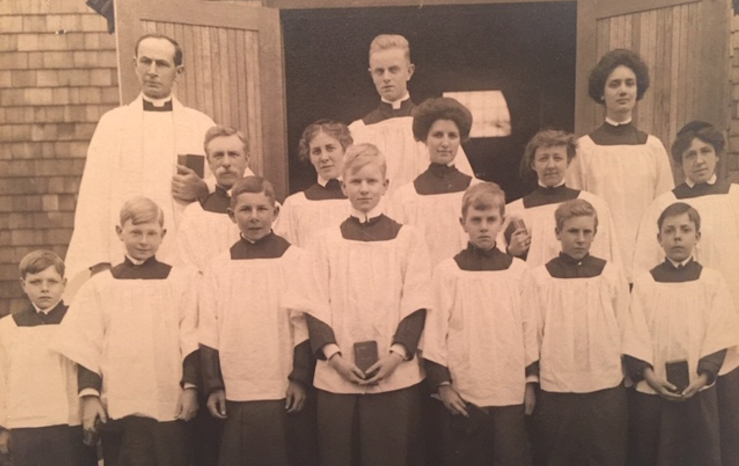
Our History
 During the weeks leading up to Trinity Sonoma’s 170th anniversary, the church newsletter carried seven chapters of church history from the very early days of the 1850’s to the present day. The early selections are based on the book by parishioner Jim Rawls: Restless Hearts: A Glance at the Background and Origins of Trinity Episcopal Church, 2003. We hope you enjoy learning more about Trinity.
During the weeks leading up to Trinity Sonoma’s 170th anniversary, the church newsletter carried seven chapters of church history from the very early days of the 1850’s to the present day. The early selections are based on the book by parishioner Jim Rawls: Restless Hearts: A Glance at the Background and Origins of Trinity Episcopal Church, 2003. We hope you enjoy learning more about Trinity.
From Brussels to San Francisco to Sonoma. Trinity Episcopal Church traces its origins to the opening of an Episcopal school for girls, founded on the Sonoma plaza by the Rev. John Leonard Ver Mehr on September 1, 1853. That foundational event signaled the beginnings of Episcopal worship in the Sonoma Valley. But how did Rev. Ver Mehr get here? And who was he?
John Leonard Ver Mehr (1809-1886) was a considered a visionary. In a history of the Diocese of California, he is described as tender and lovable, impulsive, and enthusiastic, yet impractical and unskilled in worldly matters. He was fluent in French, German, and English and taught classes in Greek and Latin. Ver Mehr was also a deeply religious man. For generations his family had been Protestants, members of the Walloon Church of Belgium.
Ver Mehr left Brussels for the United States in 1843 with his wife Adelaide and their young son Malan. He longed for a spiritual home. And it was his longing that brought him to the Episcopal Church—even then a model of inclusiveness for the Body of Christ. He was baptized by the bishop of New Jersey and ordained a priest in 1847.
Ver Mehr arrived in San Francisco during the wild days of the Gold Rush. The population was booming. Initially he thought he would be assigned to a mission, but the mission had already been organized into a parish church. He decided to establish his own missionary congregation at Grace Church, San Francisco. At the time Grace Church, now Grace Cathedral, was a shingle roofed, clapboard chapel—not the splendid cathedral that stands on Nob Hill today. He became rector of Grace Church which opened for services on February 4, 1910.
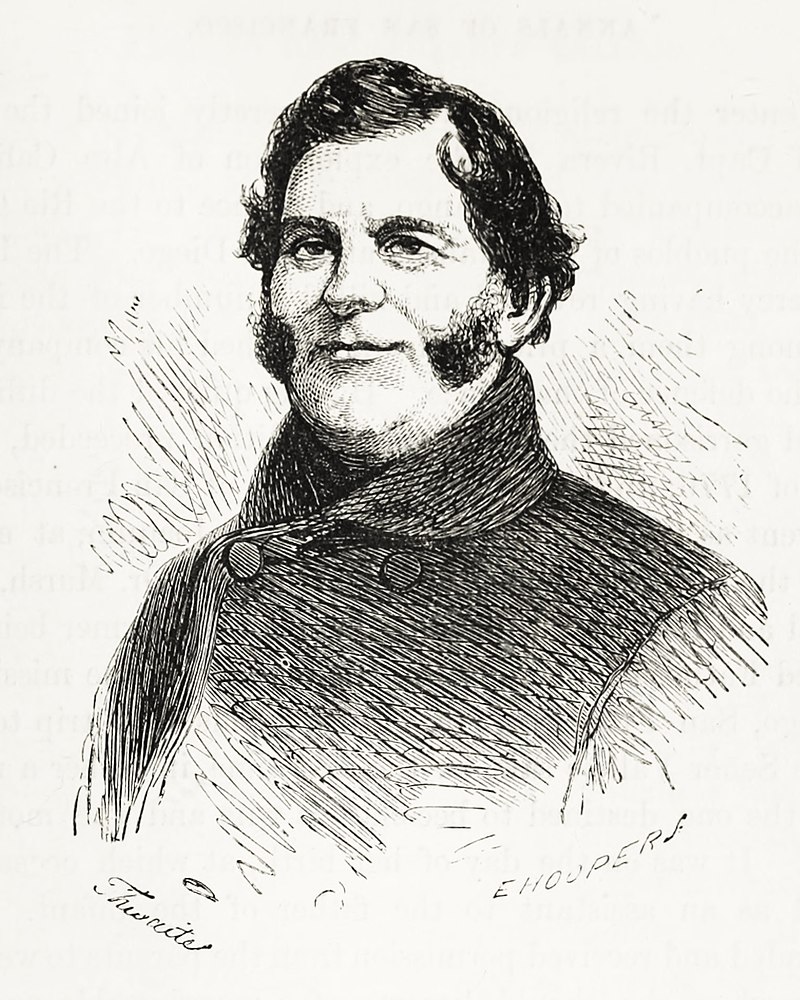
General Mariano Guadalupe Vallejo, 1807-1890
Call to Sonoma. A few years later, Ver Mehr was called to Sonoma to administer the sacrament to three children of a local resident (the baptisimal certificate hangs in the church). Rev. Ver Mehr was relieved to take a break from the hustle bustle of San Francisco for few days and he found the Sonoma Valley “a kind of paradise.” While in Sonoma, he accepted an invitation to call upon General Mariano Guadalupe Vallejo at his home Casa Grande, overlooking Sonoma Plaza. The patriarch of Sonoma, and father of numerous daughters, Vallejo invited Ver Mehr to move to the valley and open a local school for girls.
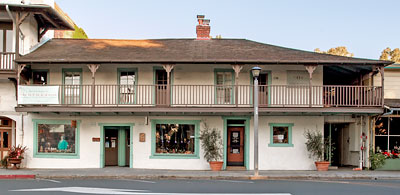
Leese-Fitch Adobe today, built c.1836
Ver Mehr arranged to rent a two-storey building owned by Vallejo’s sister-in-law. The building, known as the Leese-Fitch Adobe, still stands today on the southwest corner of the plaza. The school opened as St. Mary’s Hall on September 1, 1853. Its founding marks the beginning of Episcopal worship in the Sonoma Valley. Ver Mehr’s ministry was especially noteworthy because of the inclusiveness of the school—side by side were English speaking and Spanish speaking students. Among those were 3 of General Vallejo’s daughters.
He was also one of the first Sonomans to regularly commute to San Francisco. Every two weeks he would make a round trip to the city to conduct services at Grace Church, the church that he had founded. After a time, Ver Mehr resigned his post at Grace and devoted his ministry to Sonoma full time.
In 1856, Ver Mehr’s family experienced an enormous tragedy. A diphtheria epidemic was ravaging the country. Vallejo’s first grandson and namesake had died from the disease. Ver Mehr officiated at his funeral. Then a week later, the Ver Mehrs lost 4 of their young daughters, aged 3-11. The family never recovered. Ver Mehr ever after referred to them as his “four little angels.” Following this loss, the Ver Mehr family left Sonoma permanently.
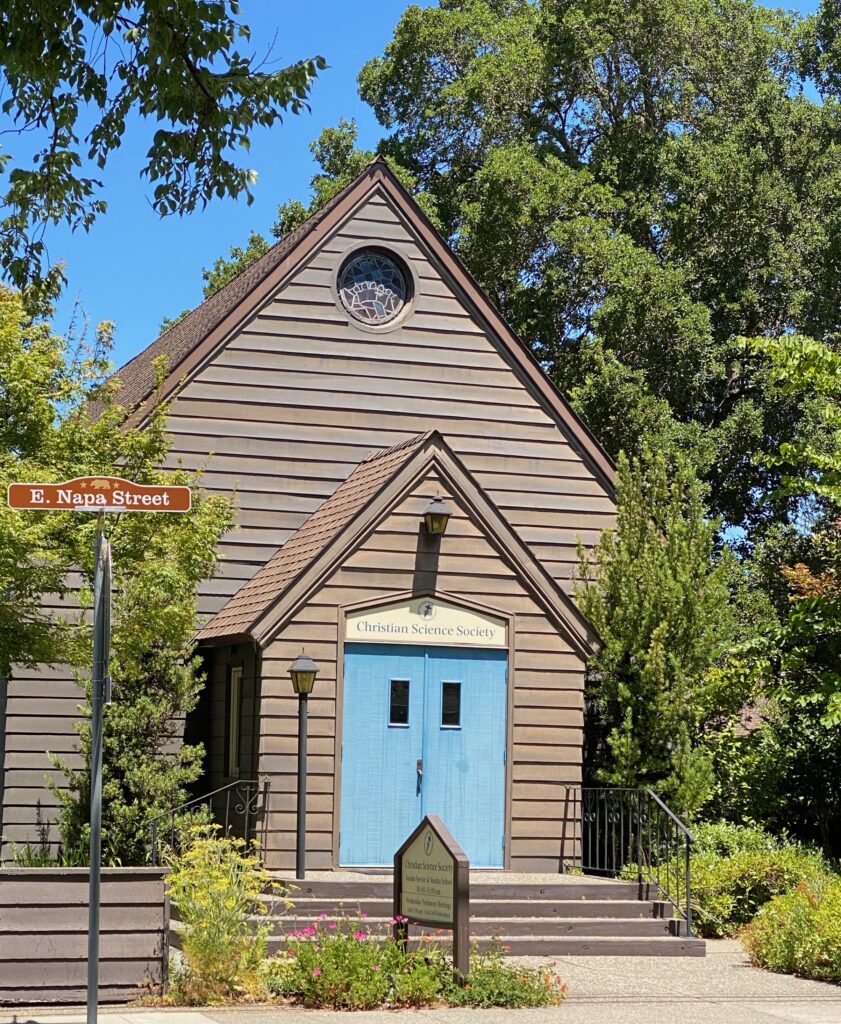
First permanent home of Trinity Sonoma, E. Napa & 2nd Street East
Current home of Christian Science Church
From St. Mary’s Hall to St. Barbara’s Guild & the Great War. The seeds of faith planted in Sonoma by the Rev. John Ver Mehr slowly took root. After he left Sonoma, Episcopal services were conducted irregularly by various clergy from surrounding parishes and communities for the next few decades. In 1911, Rev Thomas Parker Boyd, rector at Ascension, Vallejo, began conducting regular midweek services in Sonoma. On June 1, 1911, Boyd became the official priest-in-charge at Sonoma.
Rev. Boyd led his first service on a rainy weekday evening, attended by a dozen faithful communicants. The midweek services continued until he led his first Sunday services on June 1, 1911. By then he resigned his position in Vallejo to take the Sonoma position for $100.00 per month. His enthusiasm generated 14 candidates for confirmation by the end of his first month on the job!
Boyd had a scholarly and progressive background. Rev. Boyd was part of the Emmanuel Movement (Episcopal) Church, Boston, Massachusetts, which recognized the value of body, mind and spirit in the treatment and healing of illnesses, including alcoholism. The Emmanuel Movement was an attempt to combine spirituality with a kind of simple lay psychotherapy. The Emmanuel Healing Movement was the subject of Dr. Boyd’s first book: “The How and Why of the Emmanuel Movement,” published in 1909.
The Bishop of the Diocese of Northern California granted mission status for an Episcopal mission in the town of Sonoma on January 21, 1912. At first, services were conducted in a large storeroom. Eventually, Trinity occupied its first permanent home during Lent in 1912. This building still stands on the northeast corner of East Napa and Second Street East. Today the building houses the Christian Science Church.
St. Barbara’s Guild was established about this time as the fundraising and hospitality arm of the parish. The ladies of the Guild were raising money in earnest for a building lot, clearing $250 from a single night’s church bazaar, (about $8,000 today!)
Having accomplished a great deal in his time at Trinity, Rev. Boyd resigned his position in 1913 to be replaced by Rev. Irving Spencer. Spencer’s tenure was marked by the largest offering ever received by the parish to date: $51.00 (about $1,600 today).
Among the church’s strongest early leaders was the Rev. William Therrel Holt, the son of the Ven. David Holt who occasionally had conducted services at Sonoma in the first decade of the 20th century. Rev. Holt first served as Trinity’s vicar from 1915-1917—years when the nation’s focus was on the Great War (World War I). Holt noted that Trinity was entering a new era, with more loyalty to the church, the prayers of the faithful and more financial security for the church.
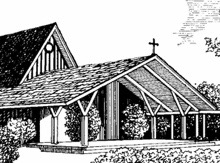
1951: A Full Fledged Parish: A series of 15 priests served Trinity during the early decades of the 20th century. Two priests in particular had the greatest impact on Trinity’s modern development. The Rev. Dr. Harold St. George Buttrum who remained at Trinity for 11 years from 1945-1956. Under his leadership, Trinity became a full-fledged parish in 1951. This was a fitting anniversary as it marked the centennial of John Leonard Ver Mehr’s first visit to Sonoma.
The priest with the longest tenure in the history of Trinity was the Rev. Martin Knutsen. He arrived in Sonoma in 1959 and remined as rector for 27 years. His most notable accomplishment is the design and construction in 1962 of the present church buildings and grounds.The site at 275 East Spain was acquired from parishioners and community leaders Carroll and Katherine Andrews. Landscaping continued the following year. (Workers were digging holes for the trees in Abbot Courtyard on November 22, 1963, the day John F. Kennedy was assassinated.)
Fr. Knutsen challenged the architectural firm of Ian MacKinlay and Associates to design a building for worship that “felt like a spiritual home.” The resulting building, with its warm redwood walls and intimate relationship between altar and pews, admirably achieved the rector’s goal.
About Architect Ian Mackinlay: San Francisco based Ian Mackinlay, is an award-winning architect who has directed hundreds of projects throughout the world. His work can be seen in Hawaii, Guam, Nauru, Saudi Arabia, Germany, France, Austria, and Italy as well as the United States. Since 1980, he has worked on design and construction defect cases focusing on forensic architecture. Prior to founding IMA in 1990, Ian was president and chairman of Mackinlay/Winnacker/McNeil Architects (now known as MWM), the Oakland, California–based firm he founded in 1959. Mackinlay earned a Bachelor of Architecture degree from the University of California, Berkeley, where he lectured in architecture from 1957 to 1960.
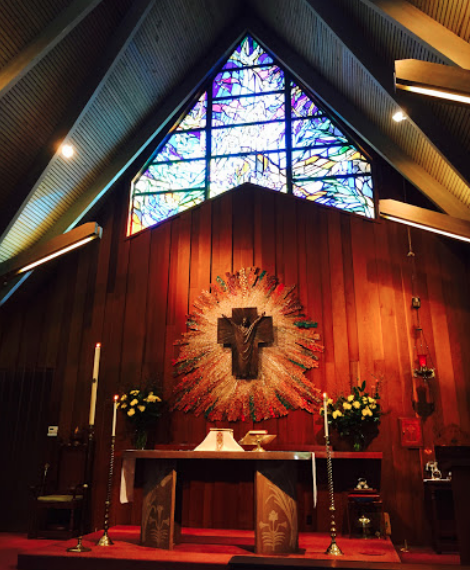
Trinity Altar
Trinity Furnishings & Sculpture: Among the outstanding furnishings in the Trinity sanctuary are the altar and communion rail, adorned with carvings by parishioner and famed sculptor Marian Brackenridge. Sonoma resident Marian Brackenridge (1903-1999) was an American sculptor known for her portrait busts, bas reliefs and religious works. Born in Buffalo, New York, Brackenridge was the eldest of three sisters.
Brackenridge attended the Art Student’s League of New York where she studied under Leo Lentelli. Her work was part of the sculpture event at the 1932 Summer Olympics (Los Angles). Between 1956 and 1976, Brackenridge modeled a series of half-life-sized niche figures for Washington National Cathedral. Brackenridge’s most familiar works may be the bronze markers that she modeled for the 1960 centennial of the Pony Express at the 8 stops on the mail route.Brackenridge never married. In 1941, she moved to “La Brenta” – an 1892 California Craftsman style house and studio at 281 East NapaStreet, Sonoma, where she lived until her death. A portrait relief of Brackenridge marks her grave in Sonoma’s Mountain Cemetery.
Putting Trinity’s Mission Statement to Work: Trinity’s next two rectors, the Rev. Richard Simpson, and the Rev. Canon Stephen N. Brannon, oversaw continued expansion of the church’s ministry. Fr. Simpson served from 1987-1993, a time of revitalization of the Sunday school and the inauguration of services to youth. At an all-church conference early in his tenure, the parish adopted what continues to be our mission statement: “We at Trinity are committee to be an expression of God’s love through Jesus Christ: teaching and nurturing one another in our journeys in faith, equipping one another for service, and expressing God’s love to our community and the world.” This statement of commitment expressed the spirit that had so often characterized Episcopal ministry in Sonoma.
The Trinity campus has been the home of several non-profits over the years including Operation Youth, Sonoma Home Meals, and Sonoma Preschool Academy.
Operation Youth, an organization that began at Trinity during Fr. Simpson’s tenure, later evolved into a community-based service for teens. Sonoma’s Teen Services www.teenservices.org describes it as founded by John Randall and eventually consisting of the student-run No-Name Café at Sonoma Valley High School.
Meals-On-Wheels (AKA Sonoma Home Meals) It was during Fr. Knutsen’s tenure that Trinity became the home of Meals-on-Wheels, an independent organization that serves hundreds of meals to those in need throughout Sonoma Valley 5 days a week. MOW is an entirely volunteer organization of over 100 volunteers.
Sonoma Preschool Academy: The Preschool rents space on the campus and serves children of preschool age. The preschool is so popular that it is often completely subscribed.
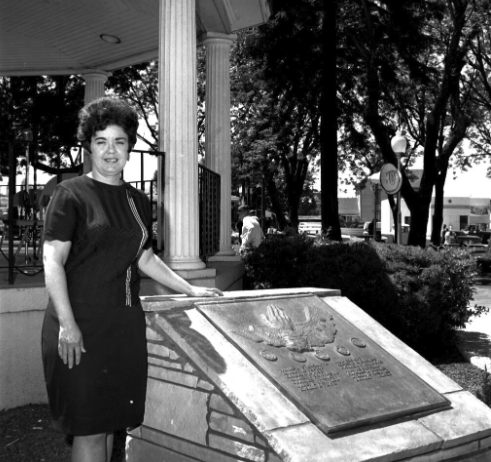
Decorative Additions to the Church: During the 1990’s additional embellishments were added to the church. The stained-glass window above the altar, was donated by parishioner Helen Pendleton as a memorial to her niece Eleanor Pendleton Price. The architects had designed the space with clear glass. Another striking addition was the bronze crucifix and mosaic above the altar, memorial gifts of parishioners James and Marguerite Vanderbilt. The crucifix, depicting the risen Christ, was designed, and created by Cuban-born artist Rosa Estebañez; the background mosaic, by artisan Anthony Stellon.
About Artist Rosa Estebañez: Sonoma County was the adoptive home of sculptor Rosa Estebañez, whose work can be seen throughout the Bay Area at churches, wineries, and colleges. Born in Cuba in 1927, Estebañez quickly rose to prominence as a gifted artist after graduating from the National School of Art in Havana in 1951 with a master’s degree in art. She became the official “escultora” (sculptress) for the Cuban government under then-President Fulgencio Batista. Estebañez fled Cuba with her 10-year-old son, Jorge, in 1960 settling in Petaluma. In 1977, Estebañez hosted a seven-part television series titled “How to Sculpt with Rosa” on KQED’s Open Studio, which led to a self-published book of the same name a few years later. In 1978, she opened her own art gallery on Petaluma Boulevard North called La Galeria de Rosa.
Fr. Stephen Brannon: Fr. Brannon arrived at Trinity in 1995 serving as rector until 2003. Under his leadership, Trinity continued to build upon the traditions of its rich heritage. The meditative labyrinth was added among Trinity’s circle of redwood trees. A new stewardship hymn was composed by parishioner, the late John T. Burke, “Come Join Our Journey of the Heart.” Seekers of active prayer joined the Centering Prayer sessions on Saturdays, Celtic classes, and a multitude of short-term courses of study. Reminiscent of Ver Mehr’s financial struggles in the mid 1880’s and the fund-raising bazaars of the early 1900’s, Trinity turned to supplementing its parish income with English Country Faires, carwashes, and trash pickups.

Memorial Garden Blossoms: Parishioners generously supported a few special projects, including the construction of a Memorial Garden and Columbarium just to the east of the Celtic cross in leafy Abbot Courtyard. This lovely tranquil space was dedicated by the Re. Rev. Jerry Lamb, Bishop of the Diocese of Northern California in September 2000.
Also noteworthy was the donation of jewelry, precious stones, gold, and silver from many participating families in the parish and broad community to fashion a Millennium Memorial Chalice to be use in the celebration of Holy Communion on special occasions.
More about Fr. Stephen Brannon: Rev. Brannon is an Illinois native. He earned an A.B. at the University of Illinois, and an M. Div. The General Theological Seminary of the Episcopal Church, and a J.D. at the University of San Francisco Law School. He is a member of the California Bar and Federal Bar. Rev. Brannon served as a priest for Churches and University Campuses in Illinois and California. He was Chancellor of Province 8 of the Episcopal Church. Upon his retirement as Rector of Trinity, in 2005, he was named Rector Emeritus. He served as a Volunteer Chaplain for Sonoma Police Department, Sonoma County Sheriff, and California Highway Patrol, and volunteered as a pro bono lawyer representing abused women and children in Domestic Violence cases in Sonoma County Superior Court. His wife Barbara of 48 years died in 2013. Fr. Stephen has three children and two grandchildren, plus 26 foster children including 18 teenage girls! He lives happily in retirement in Sonoma.
Role of Women and Girls: Recalling its origins as a school for girls, Trinity continued to honor the role of women and youth. In 2002 the parish called the Rev. Helen McPeak to serve as assistant rector, focusing her ministry on children, youth, and young families. Trinity also served as the home for Presentation School, an independent school in the Catholic tradition. Here a circle was completed. Ver Mehr had housed his Episcopal school in the home of a welcoming Roman Catholic, and Trinity Episcopal Church now gladly hosted a Catholic School. St. Barbara’s Guild remained in active service, and women served in all positions of lay leadership.
Ethnic Diversity: Reflecting statewide trends, the ethnic diversity of the Sonoma Valley steadily increased during Fr. Brannon’s tenure. The 2000 census revealed that ethnic minorities made up more than half of the state’s population; in other words, every California was a member of one minority group or another. The largest group were Latinos. Trinity’s tradition of outreach was expressed in ministries such as Beyond Ourselves and the establishment of a sister-parish relationship with the Cathedral of San Juan Evangelista in El Salvador. Financial contributions provided scholarship and other forms of aid to numerous Salvadoran families.
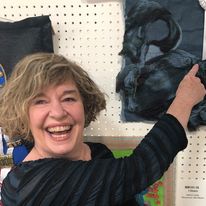
Trinity’s First Woman Priest: Upon the retirement of Fr. Stephen from Trinity, the search was on for a new rector. This was going to be a difficult search, as Sonoma had become an increasingly expensive place to live, making it less attractive for younger, less affluent clergy to live. The Rev. Susan Allison-Hatch answered the call. Rev. Susan had been sent to seminary from St. Michael’s, Albuquerque (New Mexico) in 2000 and came to Trinity in 2006. Before entering the priesthood, Rev. Susan had been a teacher and school administrator. Rev. Susan served parishes in the San Francisco Bay Area and volunteered as a chaplain in the ER of Highland Hospital in Oakland. Susan resigned from Trinity in 2007 to return to her native New Mexico.
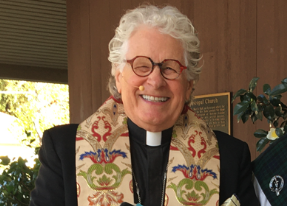
Fr. James Thomas: Fr. Jim as he is affectionately known, was appointed as priest-in-charge at Trinity by the Bishop Barry Beisner in 2010. The plan was that he would stay until Trinity got back on its feet and hired a new rector. He ended up staying 13 years, retiring in May 2023. When Fr. Jim arrived on campus, he discovered significant deferred maintenance on the physical plant. Afterall, the church buildings were now nearly 50 years old. In addition to the need for roofing, gutters, termite repair, etc., there was a need for handicapped access. Several parishioners either were disabled or had family who were, and they could not easily move about the campus. Fr. Jim began his campaign of updating the facilities. He enlisted the help of parishioners, especially architects Ray St. Francis and Susan Peterson. Together they put together a work plan that was to be accomplished over time, since there were not sufficient funds to do all the work at once. Ramping and signage was installed. Eventually the heating and air conditioning were updated. (The church had no air conditioning until then.) Sewer systems and drainage systems were updated.
Over a period of a decade, the buildings were brought up to standard and made accessible and comfortable for all. Also, during his tenure, two “wings” were added to the columbarium tripling the size of the Memorial Garden space to include more niches. The columbarium was consecrated by Bishop Meghan Traquair, Bishop of the Diocese of Northern California in 2023.
During his time as priest-in-charge, Fr. Jim and his wife Sally continued the lively, active church life experienced by earlier clergy. Sally took over the Sunday school with help from other lay leaders. The classes were large at the time, sometimes up to 25 children—including all ages, from 4 years old to high school age.
Rev. Lisa Biersch Cole was sponsored as transitional deacon for the priesthood from Trinity. She spent 4 years at Trinity working with adults and children and exploring new ways to worship. She brought in new technologies and expanded the social media presence of the church. Among the initiatives, Rev. Lisa initiated were Advent Evening Prayer; Sonoma Prayer Fridays; and other non-Sunday prayer series.

The Pandemic, 2020-2021: The Covid 19 pandemic affected everyone in one way or another. Initially, places of worship resisted shutting down, but it was inevitable that they do so because of the danger of infection. Trinity remained closed for over a year. As soon as Fr. Jim learned that we would be shut down, he, along with the Vestry, initiated a project to offer live streaming of church services to those at home. The first live stream was done with an iPhone as a camera with the streaming done to Facebook. The service consisted of 4 people: a priest, a musician, an acolyte, a live stream techie. All this took place each Sunday at 9am in an otherwise empty church.
It was decided to have only one service at 9am, rather than for former two: at 8am and 10:30am. It was all the group could do to put together the one service. Eventually, as the pandemic stretched on, it became obvious that better equipment was needed. A SlingStudio set up was purchased, including a professional camera, along with an iPad as controller. The broadcast venue became YouTube instead of Facebook. At its height Trinity reached 75-80 people per week. Even after the pandemic, the live stream continues to reach 35-40 people per week.
Regathering occurred slowly with masks and seating far apart. People trickled back into church, but many were concerned about getting infected and the statistics for getting infected were still high.
By 2022, services returned to mostly normal, but there was a considerable loss of momentum for the Trinity ministries, as there was for other churches. The entire Sunday school was gone. In the two years since the pandemic hit, entire families had moved out of the area. The schools had experienced almost a 20% drop in school attendance, with some closing. The drop in school attendance, coupled with the increase in housing costs, priced young families out of Sonoma. There were now fewer young families. There would be a need for a massive rebuilding effort.
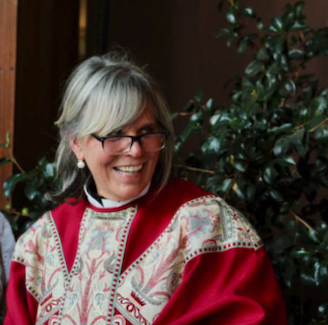
Today: The Rev. Lisa Biersch Cole. That brings us to today. On October 8, 2023, The Rev. Lisa Biersch Cole returned to Trinity Episcopal Church, this time as Priest in Charge. Her appointment brought a new era of hope for the growth and worship of God in the Sonoma Valley.
What will the next 170 years bring to the Sonoma Valley? To Trinity Church? Only time will tell. In the meantime, Trinity will maintain a strong presence of prayer, service, and outreach to the community.
